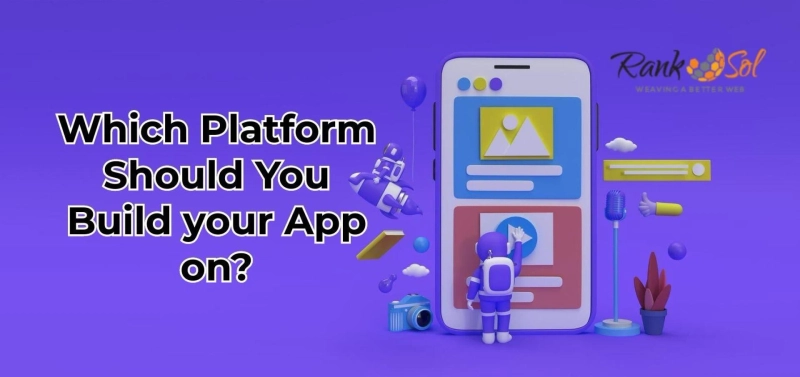What to choose? iOS or Android
What do you do after you\'ve determined that constructing an app is the best answer for your company\'s main business problem? Well, as you start off with technical needs, you\'ll need to choose a platform to build on, but how do you know which one would be best for your product?
The best practice for mobile app development is to create and release versions for both iOS and Android, which control 97% of the worldwide mobile market share. It\'s ideal for building two platforms at once, but that isn\'t always achievable due to limitations in areas such as time, money, and resources. Instead, you may focus on getting one platform up and running before adding the other.
Android Vs. iOS
There are benefits to using one platform over another, but you need to do your homework to figure out which OS is best for your product.
To assist you in determining whether iOS or Android is more suited for your product, this blog presents a comparison of the two operating systems across four criteria: target market, monetization opportunities, development time, and cost.
Audience
When comparing the user bases of iOS and Android, there is an immediate distinction. In order to choose the best operating system for your app, you must first determine the app\'s ultimate purpose and target demographic.
Android now has almost two-thirds of the worldwide market share and has more total app downloads than Apple\'s iOS platform. According to Sensor Tower, in 2018, the Google Play Store had almost 75.7 billion new app installations throughout the globe. By contrast, the App Store only brought in $29.6 billion. iOS users have a greater engagement rate and spend more money on applications and in-app purchases, even if Android may have more downloads overall.
Android is also quite popular in developing and low-income nations, whereas iOS users are disproportionately located in the North American and Western European regions. Apple\'s iOS customers tend to be younger, wealthier, and more educated than the general population.
Monetization
Your monetization plan will influence whatever platform you build initially. Each OS is better suited to different methods of making money. It\'s common knowledge that iOS applications generate more money. While Apple may have fewer users and fewer software downloads, the App Store nevertheless produces far more cash. Apple\'s App Store earned over 88% more than Google\'s Play Store at year\'s end in 2018. iOS is the more profitable platform if you want to monetize via a subscription model or in-app purchases. The ad-based strategy, on the other hand, has proven to be very profitable for Android applications.
While iOS still brings in much more money, Google Play saw a 27.3% rise in revenue year over year.
Project Timeline
When do you hope to release your app? Which platform you should prioritize developing for might be heavily influenced by how much time you have available. Due to lengthier release cycles and device fragmentation, developing for Android often requires more time. Because there are hundreds of Android devices with varying screen sizes and OS versions, developing an app that is compatible with all of them usually takes extra effort.
iOS devices are becoming less uniform than they once were, despite Apple\'s complete control over the hardware and software and the fact that there are significantly fewer iOS devices than Android smartphones. Screen sizes and user interface restrictions have expanded for app makers with the release of the iPhone X series.
When compared to other platforms, iOS development may be swift, but getting your app approved by the App Store might take longer due to the store\'s stringent guidelines and high-quality standards. As a comparison, Android applications are often approved within a day or two, and updates may be sent within a couple of hours.
Budget
There is a direct correlation between the size and scope of a project and its associated cost for mobile app development. The cost of developing for either iOS or Android is not much different.
However, if you want to support a wide variety of devices and operating system versions, your app will take longer to develop and cost more money to release. The development cost for both platforms will be around the same if the scope is adjusted to be more in line with supporting a comparable number of devices and OS versions on iOS and Android.
Making a choice
Your company\'s needs should guide your choice between developing for iOS and Android simultaneously.
You should prioritize iOS if your audience is affluent North Americans and you want to make money off of in-app sales. Android might be the best choice if you want to reach a larger audience worldwide and profit through in-app advertisements.
Is There Another Choice?
Sometimes, a web app is the most practical solution for your company. Web applications are webpages that have the same functionality as native apps but need no additional space on the user\'s device. As long as the program can be launched in a web browser like Chrome, Safari, or Firefox, it will work on both iOS and Android. When compared to native app development, the cost of creating and maintaining a web app is far lower. Web applications, on the other hand, are often not as engaging or intuitive as native apps and can\'t make use of the device\'s hardware or utilities.
Conclusion
Your app\'s intended content and your company\'s overarching objectives should guide your decision about the best platform for your mobile app. Your company\'s success hinges on making the right decision based on the needs of your intended audience and your most frequent customers. Choosing the right company like Rank Sol to get you mobile application development services is also necessary for a business.



